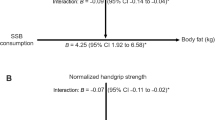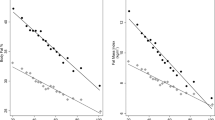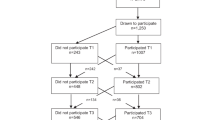Abstract
BACKGROUND: A global epidemic of obesity is developing. Current prevalence rates are about 20–25% in American adults and 15–20% in Europeans.
OBJECTIVE: We investigated the association between population levels of physical activity, dietary fat, dietary fiber and indicators of body fat.
DESIGN: Cross-cultural study of 16 cohorts of, in total, 12 763 middle-aged men in seven countries. These men were examined between 1958 and 1964.
MEASUREMENTS: Height, weight and subscapular skinfold thickness were measured. Information about job-related physical activity and diet was gathered by questionnaire.
RESULTS: The population average body mass index (weight/height2) varied between 21.8 and 26.0 kg/m2 and the population average subscapular skinfold thickness between 8.4 and 23.7 mm. The population average physical activity index and dietary fiber intake were both strongly inversely related to population average subscapular skinfold thickness and explained together 90% of the variance in subscapular skinfold thickness. Similar but less strong results were obtained for average population body mass index.
CONCLUSION: At the population level job-related physical activity and dietary fiber but not dietary fat, are important determinants of subscapular skinfold thickness.
This is a preview of subscription content, access via your institution
Access options
Subscribe to this journal
Receive 12 print issues and online access
$259.00 per year
only $21.58 per issue
Buy this article
- Purchase on Springer Link
- Instant access to full article PDF
Prices may be subject to local taxes which are calculated during checkout



Similar content being viewed by others
References
Seidell, JC, Flegal KM . Assessing obesity: classification and epidemiology Br Med Bull 1997 53: 238–252.
Seidell JC . The impact of obesity on health status: some implications for health care costs Int J Obes Relat Metab Disord 1995 19 (Suppl 6): S13–S16.
World Health Organization . Obesity: preventing and managing the global epidemic World Health Organization: Geneva 1998.
Amos AF, McCarty DJ, Zimmet P . The rising global burden of diabetes and its complications: estimates and projections to the year 2010 Diabet Med 1997 14 (Suppl 5): S1–S85.
Prentice AM . Manipulation of dietary fat and energy density and subsequent effects on substrate flux and food intake Am J Clin Nutr 1998 67: 535S–541S.
Rolls BJ, Bell EA, Castellanos VH, Chow M, Pelkman CL, Thorwart ML . Energy density but not fat content of foods affected energy intake in lean and obese women Am J Clin Nutr 1999 69: 863–871.
Bray GA, Popkin BM . Dietary fat intake does affect obesity! Am J Clin Nutr 1998 68: 1157–1173.
Willett WC . Dietary fat and obesity: an unconvincing relation Am J Clin Nutr 1998 68: 1149–1150.
Lissner L, Heitmann BL . Dietary fat and obesity: evidence from epidemiology Eur J Clin Nutr 1995 49: 79–90.
Prentice AM, Jebb S . Obesity in Britain: gluttony or sloth? Br Med J 1995 311: 437–439.
Deurenberg P, Yap M, van Staveren WA . Body mass index and percent body fat: a meta analysis among different ethnic groups Int J Obes Relat Metab Disord 1998 22: 1164–1171.
Heitmann BL, Swinburn B, Carmichael H, Rowley K, Plank L, McDermott R, Leonard D, O'Dea K . Are there ethnic differences in the association between body weight and resistance, measured by bioelectrical impedance? Int J Obes Relat Metab Disord 1997 21: 1085–1092.
Keys A, Aravanis C, Blackburn HW et al. Epidemiological studies related to coronary heart disease: characteristics of men aged 40–59 in seven countries Acta Med Scand 1967 460: 1–392.
Keys A (ed) . Coronary heart disease in seven countries Circulation 1970 41 (Suppl 1): 1–211.
Keys A . Seven countries: a multivariate analysis of death and coronary heart disease Harvard University Press: Cambridge, MA 1980.
Kromhout D, Keys A, Aravanis C et al. Food consumption patterns in the 1960s in seven countries Am J Clin Nutr 1989 49: 889–894.
Osborne DR, Voogt P . Soxhlet method In: Analysis of nutrients and foods 1st edn: Academic Press: London 1978 155–156.
William S (ed) . Total dietary fiber in foods; enzymatic gravimetric method. Changes in methods J Ass Off Anal Chem 1985 68: 399.
Han TS, Seidell JC, Curral JEP, Morrison CE, Deurenberg P, Lean MEJ . The influence of height on waist circumference as an index of adiposity in adults Int J Obes Relat Metab Disord 1997 21: 83–89.
Donahue RP, Abbott RD, Bloom E, Reed DM, Yano K . Central obesity and coronary heart disease in men Lancet 1987 i: 821–824.
Higgins M, Kannel WB, Garrison R, Pinski J, Stokes J III . Hazards of obesity—the Framingham experience Acta Med Scand 1988 723 (Suppl): 23–36.
Seidell JC . Dietary fat and obesity: an epidemiologic perspective Am J Clin Nutr 1998 67 (Suppl): 546S–550S.
Drenowski A, Popkin BM . The nutrition transition: new trends in the global diet Nutr Rev 1997 55: 31–43.
Hill JO, Peters JC . Environmental contributions to the obesity epidemic Science 1998 280: 1371–1374.
Egger G, Swinburn B . An ‘ecological’ approach to the obesity pandemic Br Med J 1997 315: 477–480.
Heitmann BL, Lissner L, Sörensen TIA, Bengtsson C . Dietary fat intake and weight gain in women genetically predisposed for obesity Am J Clin Nutr 1995 61: 1213–1217.
Heitmann BL, Kaprio J, Harris JR, Rissanen A, Korkeila M, Koskenvuo M . Are genetic determinants of weight gain modified by leisure-time physical activity? A prospective study of Finnish twins Am J Clin Nutr 1997 66: 672–678.
Acknowledgements
The authors are grateful to the principal investigators in the different countries who initiated the Seven Countries Study and for their effort in carrying out the study for more than 25 y.
Author information
Authors and Affiliations
Consortia
Corresponding author
Rights and permissions
About this article
Cite this article
Kromhout, D., Bloemberg, B., Seidell, J. et al. Physical activity and dietary fiber determine population body fat levels: the Seven Countries Study. Int J Obes 25, 301–306 (2001). https://doi.org/10.1038/sj.ijo.0801568
Received:
Revised:
Accepted:
Published:
Issue Date:
DOI: https://doi.org/10.1038/sj.ijo.0801568
Keywords
This article is cited by
-
Changes in 10-year cardiovascular risk and behavioral risk factors in men in Crete, Greece, since the Seven Countries’ Study (1960–1997)
Journal of Public Health (2018)
-
Does action planning moderate the intention-habit interaction in the exercise domain? A three-way interaction analysis investigation
Journal of Behavioral Medicine (2012)
-
Body Mass Index and Diverticular Disease: A 28-Year Follow-Up Study in Men
Diseases of the Colon & Rectum (2008)
-
Do Energy Density and Dietary Fiber Influence Subsequent 5‐Year Weight Changes in Adult Men and Women?
Obesity (2006)
-
Netherlands Research programme weight Gain prevention (NHF-NRG): rationale, objectives and strategies
European Journal of Clinical Nutrition (2005)



